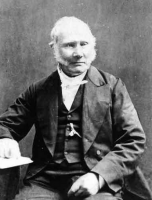










The Reverend Dr Robert Stirling was a Scottish clergyman, and inventor of the Stirling engine. Stirling was born at Cloag Farm near Methven, Perthshire, the third of eight children. He inherited his father's interest in engineering, but studied divinity at the University of Edinburgh and the University of Glasgow becoming a minister of the Church of Scotland as second charge of the Laigh Kirk of Kilmarnock in 1816. He was Minister of Galston Parish Church from 1824 until 1878.
Family
On 10 July 1819, Stirling married Jean Rankin. They had seven children.
Engineering and science
Hot air engine
He invented what he called the Heat Economiser (now generally known as the regenerator), a device for improving the thermal/fuel efficiency of a variety of industrial processes, obtaining a patent for the economiser and an engine incorporating it in 1816. In 1818 he built the first practical version of his engine, used to pump water from a quarry.
The theoretical basis of Stirling's engine, the Stirling cycle, would not be fully understood until the work of Sadi Carnot (1796–1832).
Optical instruments
While in Kilmarnock, he collaborated with another inventor, Thomas Morton, who provided workshop facilities for Stirling's research. Both men were interested in astronomy, and having learnt from Morton how to grind lenses, Stirling invented several optical instruments.
Patents
Robert, together with his brother James, an engineer, took out several further patents for improvements to the air engine and in the 1840s James built a large air engine driving all the machinery at his Dundee Foundry Company.
Bessemer process
In a letter of 1876, Robert Stirling acknowledged the importance of Henry Bessemer's new invention – the Bessemer process for the manufacture of steel – expressing a hope that the new steel would improve the performance of air engines.